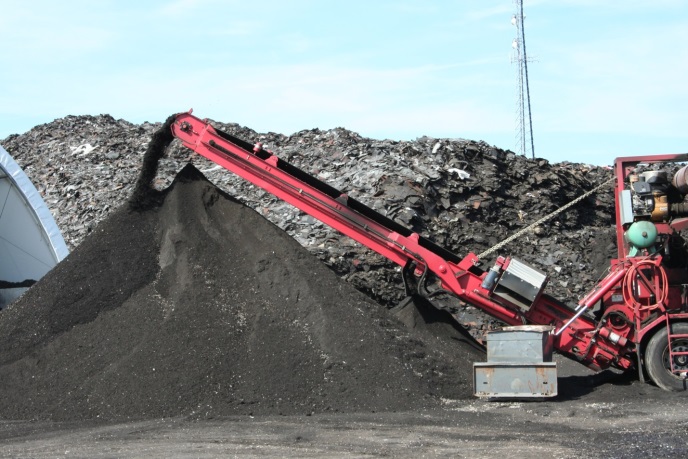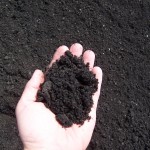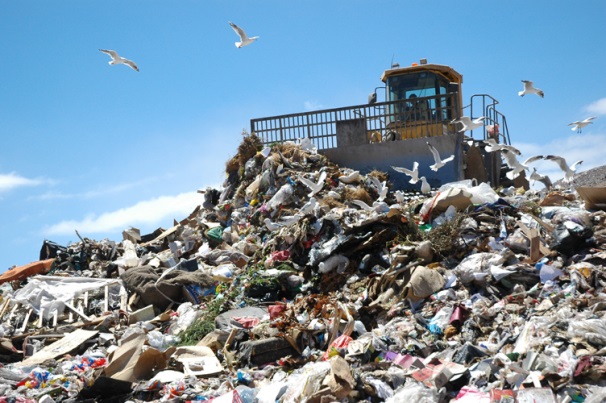 Ten (10) million tons of post-consumer waste shingles or “tear-off” shingles from replacing old roofs are generated in the U.S. every year. Another one (1) million tons of manufacturers’ waste shingles are also generated. Known as Recycled Asphalt Shingles (RAS) they are an excellent source of asphalt binder, containing 15-35%, and can be processed, reheated and combined with virgin asphalt binder to glue the new asphalt mixture together. In the last decade, transportation agencies have allowed recycled asphalt roofing shingles (RAS), to become a portion of new asphalt mixtures.
Ten (10) million tons of post-consumer waste shingles or “tear-off” shingles from replacing old roofs are generated in the U.S. every year. Another one (1) million tons of manufacturers’ waste shingles are also generated. Known as Recycled Asphalt Shingles (RAS) they are an excellent source of asphalt binder, containing 15-35%, and can be processed, reheated and combined with virgin asphalt binder to glue the new asphalt mixture together. In the last decade, transportation agencies have allowed recycled asphalt roofing shingles (RAS), to become a portion of new asphalt mixtures.
Manufactured waste and tear-offs are quite different materials, with the tear-offs having higher asphalt binder contents and harder binders. Manufacturers’ waste shingle material consists of new materials (defective shingles, tabs and trimmings) from shingle manufacturing facilities. There are no shingles manufactures with facilities in Virginia so this material is not readily available. Tear-off shingles, on the other hand, are readily available as old or damaged roofs are replaced.
 RAS is a very attractive component of an asphalt mixture because of its extremely high asphalt content. RAS can have an asphalt content in the 15 to 35 percent range, compared to RAP having a typical asphalt content of about 5 percent. New shingle waste has an asphalt content of about 20 percent; older tear-offs can have 30 to 35 percent asphalt (despite the fact that not all the asphalt from the shingles blend completely in the mix). RAS use is typically limited to about 5 percent of the total weight of the mix. Like RAP, RAS is a widely approved mixture component. Some agencies place limits on how much of the total asphalt content can be made up of recycled asphalt. 30 percent replacement by recycled asphalt is a typical limit. KYTC uses this approach. The specifications regarding the use of RAS are covered in Section 409 of the Standards.
RAS is a very attractive component of an asphalt mixture because of its extremely high asphalt content. RAS can have an asphalt content in the 15 to 35 percent range, compared to RAP having a typical asphalt content of about 5 percent. New shingle waste has an asphalt content of about 20 percent; older tear-offs can have 30 to 35 percent asphalt (despite the fact that not all the asphalt from the shingles blend completely in the mix). RAS use is typically limited to about 5 percent of the total weight of the mix. Like RAP, RAS is a widely approved mixture component. Some agencies place limits on how much of the total asphalt content can be made up of recycled asphalt. 30 percent replacement by recycled asphalt is a typical limit. KYTC uses this approach. The specifications regarding the use of RAS are covered in Section 409 of the Standards.
Additionally, RAS has a small percentage of fine aggregate that replaces the need for 100 percent virgin aggregate.
RAS comes from two sources – waste from the manufacturing of new asphalt shingles (known as tabs), and waste from the removal of old shingles from roofs (known as tear-offs). RAS from tabs and RAS from tear-offs are different. Tabs have more fine aggregate compared to tear-offs and the shingle asphalt is not as stiff. Tabs have not been exposed to the weather, only the manufacturing process. Once installed on a roof, rain and snow will wash away some of the fine aggregate (look at the small rocks at the bottom of a down spout) that covers the shingle. In addition to rain and snow, oxygen in the air will react with the asphalt causing it to oxidize like human skin. The asphalt becomes stiffer or less flexible as it ages. Given the differences in mainly the stiffness of the asphalt on the shingle, how tabs and tear-offs are used in asphalt mixes vary.
The first shingle mixes in Virginia were placed in 2006 as part of a research project. This project used tabs from a shingle manufacturing plant in North Carolina. Due to the success of this project, VDOT developed specifications to allow the introduction of RAS with tabs and RAS with tear-offs in new asphalt mixes. Because of the high percentage of asphalt binder in RAS, typically between 15 and 25 percent, the demand for virgin asphalt binder in the new mixes was reduced. Asphalt binder is the most expensive component of asphalt mixes, so the replacements of new asphalt binder with asphalt binder in the shingles resulted in lower cost mixes for the contractor and VDOT.
Since 2008, Virginia Asphalt Association (VAA) and VDOT have continued to improve the guidelines and specifications concerning RAS use in new asphalt mixes. Several asphalt contractors in Virginia use RAS in their asphalt mixes. Most of these contractors use RAS from tear-offs. Local companies have been established to take the old shingles from houses, remove the deleterious materials such as wood and nails, grind the shingles into small particles, and sell them to asphalt contractors. Not only does the reuse of asphalt shingles benefit the contractor and customer of new asphalt mixes, but the environment benefits. In the past these shingles would have been landfilled, but today much of this waste stream has been diverted to new roadways.
VAA, VDOT and asphalt contractors are conducting joint efforts to increase allowable RAS percentages in mixes used on VDOT projects. The ultimate goal is to produce a mixture that provides superior performance – independent of the RAS percentage. At the NCAT Test Track in Auburn, Alabama, asphalt mixtures containing RAS are being evaluated and compared to other non-RAS mixes. This not only will reduce the initial and long-term cost of the pavement, but has significant environmental impacts through the reduced demand on new asphalt binders and reduction in landfilled materials.
VDOT Specifications
![]() VDOT Specifications allow for the use of RAS in new asphalt mixes. RAS can be combined with recycled asphalt pavement (RAP) in new asphalt mixtures. Total replacement binder from RAP and RAS is currently capped at 30 percent. Other transportation agencies allow for higher percentages based on their experiences. VDOT has separate specifications for RAS from Tabs and RAS from Tear-offs.
VDOT Specifications allow for the use of RAS in new asphalt mixes. RAS can be combined with recycled asphalt pavement (RAP) in new asphalt mixtures. Total replacement binder from RAP and RAS is currently capped at 30 percent. Other transportation agencies allow for higher percentages based on their experiences. VDOT has separate specifications for RAS from Tabs and RAS from Tear-offs.
VDOT Special Provision for RAS with TABs in on Page 2-10
VDOT Special Provision for RAS with Tear-offs is on Page 2-12
Related Research
Much research has been performed on RAS. Some research has focused on the design of asphalt mixes using RAS while other research has concentrated on field performance. Virginia specific research includes:
Use of Manufactured Waste Shingles in a Hot-Mix Asphalt Field Project (http://vtrc.virginiadot.org/PubDetails.aspx?PubNo=08-R11)
Investigation of the Use of Tear-Off Shingles in Asphalt Concrete (http://vtrc.virginiadot.org/PubDetails.aspx?PubNo=10-R23)
National research has been performed under the guidance and direction of the National Highway Cooperative Research Program (NCHRP) and other research organizations. The National Center for Asphalt Technology (NCAT) has completed several projects on the design and in-service performance of RAS mixes. Some of the notable and recent research includes:
Effect if Rejuvenator on Performance Properties of HMA Mixtures with High RAP and RAS Contents (http://www.ncat.us/files/reports/2012/rep12-05.pdf)
Phase IV NCAT Pavement Test Track Findings (http://www.ncat.us/files/reports/rep12-10.pdf)
Frequently Asked Questions
- Why recycle shingles? U.S. Asphalt concrete producers are constantly seeking ways to reduce or extend the virgin asphalt binder they use
 in their products with a continued industry emphasis on quality and environmental assurances. Asphalt shingles contain anywhere from 19 to 36 percent of liquid asphalt binder (Townsend, Powell, & Xu, 2007) making the inclusion of even a small percentage of shingles have a significant effect on the amount of new asphalt binder required in an asphalt mix. Asphalt shingles also contain other materials (fibers, fine aggregate and mineral filler) which are commonly used in asphalt mixtures.
in their products with a continued industry emphasis on quality and environmental assurances. Asphalt shingles contain anywhere from 19 to 36 percent of liquid asphalt binder (Townsend, Powell, & Xu, 2007) making the inclusion of even a small percentage of shingles have a significant effect on the amount of new asphalt binder required in an asphalt mix. Asphalt shingles also contain other materials (fibers, fine aggregate and mineral filler) which are commonly used in asphalt mixtures.
- What are the benefits of using RAS? There is a substantial environmental benefit to the use of
 waste roofing shingles. A Wisconsin study of municipal solid waste (MSW) reported that asphalt shingles represent the third largest source of land filled material each year. Only untreated wood and food waste were higher (Cascadia Consulting Group, 2003). Thus, shrinking landfill space can be saved by using waste shingles in asphalt mixtures.
waste roofing shingles. A Wisconsin study of municipal solid waste (MSW) reported that asphalt shingles represent the third largest source of land filled material each year. Only untreated wood and food waste were higher (Cascadia Consulting Group, 2003). Thus, shrinking landfill space can be saved by using waste shingles in asphalt mixtures.
Asphalt roofing shingles constitute nearly two-thirds of the roofing market for both new homes and roof replacements. Roof installation generates an estimated 10 million tons of shingle tear-off waste and installation scrap annually. U.S. manufacturing plants generate another 1 million tons of manufacturing shingle scrap (NAHB Research Center, 1998). This represents over 2 million tons of liquid asphalt binder available for use in asphalt paving mixtures, or a replacement of almost 9 percent of the current national need for liquid asphalt binder in pavement construction.
- What are the potential savings? The savings of using waste shingles in asphalt concrete mixes can
 be significant. Incorporation 5% RAS in a mix, because of the high asphalt binder content of RAS, can replace 25% of the binder required in the mix. If new asphalt binder cost is $500 per liquid ton and the asphalt concrete mix requires a total of 6% binder the binder cost per ton of mix will be $30. If incorporating 5% RAS replaces 25% of the binder required the cost savings can be as much as $7.50 per ton of asphalt concrete mix.
be significant. Incorporation 5% RAS in a mix, because of the high asphalt binder content of RAS, can replace 25% of the binder required in the mix. If new asphalt binder cost is $500 per liquid ton and the asphalt concrete mix requires a total of 6% binder the binder cost per ton of mix will be $30. If incorporating 5% RAS replaces 25% of the binder required the cost savings can be as much as $7.50 per ton of asphalt concrete mix.
- Are all shingles the same? Tear-off shingles typically have higher asphalt binder contents than manufacturers waste because some of the aggregate or grit wears off with time. Since tear-off shingles will typically come from roofing companies who will have other options for disposing of their waste shingles, it is necessary to make the recycling process attractive through reduced tipping fees, convenient location(s), less stringent requirements on non-hazardous contaminants, or other economic incentives. Quality control during the processing of tear-offs is critical to their quality. Wood, metal from nails and other materials are removed prior to grinding the shingles to the required gradation.
- How are Recycled Asphalt Shingles (RAS) in detected in asphalt mixtures? Questions have been raised on how an owner/agency or private property owner can test to determine the presence of recycled asphalt shingles in Asphalt Mixtures. The simplest thing to do is A) conduct an AC Content Determination Test using an ignition oven test and look for fibers (should be able to see the fiberglass ones) or B) do a solvent based extraction test and look for fibers (fiberglass and organic ones). Either of these approaches should give a yes or no indication of the presence of shingles. An estimated range of shingles content used can be estimated based on the fiber content.
- Are there published “best practices” for use of RAS? Several different states, National and state trade associations; and shingle processing companies have developed guide documents that cover the use of Recycled Asphalt Shingles (RAS). While these documents contain excellent information their application and appropriateness for Virginia’s asphalt market has not been evaluated. VAA is working with VDOT on developing guidance on the specification, asphalt mix design, materials processing requirements, and use of RAS on VDOT asphalt pavements. Here is a link to the Best Practices Guide developed for North Carolina; http://portal.ncdenr.org/c/document_library/get_file?uuid=79a33b8b-f2c1-468f-a5cf-ad8995b6b96c&groupId=38361
- Where can I find other resources and references? The use of RAS in asphalt concrete mixes is very timely subject and there are numerous sources of information available from annual national conferences to guide documents listed above. They include:
- Guidelines for the use of Reclaimed Asphalt Shingles in Asphalt Pavements, NAPA publication IS 136, www.asphaltpavement.org
- CDOT Specification for the use of Recycled Asphalt Shingles, Revision of Section 401
- Best Practices for the use of RAS, CAPA 2010
- Recycled Asphalt Shingles, A Quality Control Plan. CAPA 2010